Cold allergy is one of many types of negative responses of the body to various external stimuli. The very name of this allergy suggests that an allergic reaction occurs under the influence of cold temperatures.
Until recently, medicine rejected such a diagnosis, since there is no allergen that provokes a specific reaction of the body as such, there is only a physical effect - cold. No allergen means no allergies.
But when exposed to cold air, some sensitive people experience a significant release of histamine, which causes reactions similar to other types of allergies - the development of swelling, vasodilation, redness and itching of the skin and mucous membranes. This is a response to a decrease in the temperature of the skin's thermal receptors.
Causes of cold allergies
Why does cold allergy occur? Medicine does not yet know the exact answer to this question, but with the following factors, particularly sensitive people may experience this strange type of allergy:
- When there is a sharp change in a person’s presence in an environment with normal air temperature to an environment with low temperature - in winter, especially in windy weather
- In contact with cold water - in everyday life when washing dishes, cleaning, swimming in open water
- When drinking very cold drinks or cold food
Allergy to cold often develops after severe illness and long-term treatment with antibiotics; it is believed that it has a genetic predisposition; it can occur against the background of infectious diseases (for example, tuberculosis) or parasitic diseases (roundworms in children, adults, pinworms in children, giardiasis. 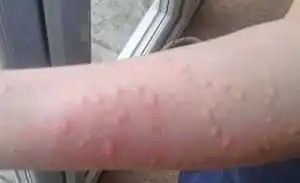
In a strong, hardened organism with a strong immune system, such temperature changes do not cause any reactions.
However, in the event of a decrease in protective forces, systemic disorders, serious illnesses, or metabolic disorders in the body, this type of allergy may occur. Stress, as we know, is the most important risk factor for immune failure, so stress-resistant people tend to get sick less often and have good health.
Provoking factors for the development of cold allergies
- The presence of allergic reactions to other irritants - food, pollen (allergy to poplar fluff), household allergies
- Some infectious diseases - mumps, measles (see symptoms of measles in adults), mycoplasma pneumonia, rubella
- Thyroid diseases, systemic lupus erythematosus, cancer
- The presence of chronic diseases - sinusitis, sinusitis, various worm infections, intestinal dysbiosis
- Recurrent skin diseases – neurodermatitis, eczema, psoriasis
- Hereditary factor
There are cases when such a reaction is hereditary in nature, that is, it is inherited and most often it is the body’s reaction to windy weather than to cold. The symptom of such an allergy is a burning sensation, not itching of the skin.
How does an allergy to cold manifest itself?
How does an allergy to cold manifest itself? Symptoms of such an allergy can have various forms of manifestation - from mild symptoms that disappear some time after contact with a cold environment, to serious recurrent skin rashes.
Skin manifestations are the most common signs. These include redness, swelling, itching of open areas of the body that have come into contact with a cold environment. After some time, the skin begins to hurt, itch, and may become blistered, similar to hives.
Cold allergies in children can even affect the inner surface of the legs, thighs, knees and manifest themselves in the form of hives. The rash is pink, dense, itchy, but goes away within a few hours. There are cases when, after a cold, the skin not only turns red and itches, but also becomes covered with a layer that begins to peel off, as with dermatitis. Sometimes bruises appear at the site of the allergy over time.
Most often, cold allergies occur on the face and hands, since these places are more exposed to the external environment, they are always open and more vulnerable.
General malaise - increased blood pressure, shortness of breath, headache and weakness.
Allergic rhinitis - the appearance of a runny nose, sneezing when going out into cold air. Swelling of the mucous membranes of the nose can either greatly complicate nasal breathing or completely block it, and upon returning to a warm room, all allergy symptoms disappear.
Signs of allergic conjunctivitis are tearing, swelling around the eyes, swelling of the eyelids, pain in the eyes. Hypersensitivity to bright light also occurs. To differentiate the diagnosis, you should definitely consult an ophthalmologist and dermatologist, since if profuse lacrimation occurs in the cold, this may be a sign of tick-borne infection (demodex) or fungus, etc.
Diagnosis of cold allergies
If you experience similar symptoms, then first of all you need to visit a therapist and an immunologist - an allergist. After a set of diagnostic and laboratory tests, it will be possible to accurately determine the cause of the allergic reaction. Cold allergies, the symptoms of which are similar to other types of allergic reactions, should be differentiated from a number of other diseases.
- Sometimes in small children of preschool age, cold allergies on the face are similar to atopic dermatitis, neurodermatitis.
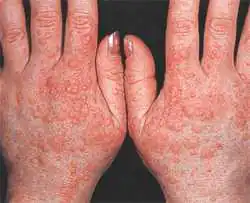
- Often similar allergic symptoms occur with idiopathic dermatosis. With this disease, heat and cold skin receptors are deregulated. Swelling, lacrimation, sneezing, and difficulty breathing occur in both cold and heat.
- Intolerance to the fur of some animals - rabbits, mink, chinchillas, woolen fabrics, sheep's wool - can also be confused with an allergy to cold. When putting on clothes and going out into the cold, a person returns with a rash and swelling of the nasopharynx; as a result, this can be assessed as a reaction to the cold, and not an allergy to wool or fur.
- The situation is similar with perfume products. Typically, perfume is applied to the forearm, neck, face, and an allergic rash can be caused by cosmetics and perfumes, and not by cold.
When symptoms appear, it is important to make a correct diagnosis, and only after differentiating the signs of allergy can a doctor confirm this disease. Then, the question arises: is an allergy to cold treatable?
How to treat allergies to cold
The inability to eliminate an allergen such as cold makes the fight against such an illness quite difficult. If the patient is diagnosed with an allergy to cold, treatment in this case is purely symptomatic. It is only possible with the help of antihistamines to slightly reduce its manifestations, or to protect exposed areas of the body as much as possible from exposure to negative temperatures. You can reduce the occurrence of allergic reactions if:
- Before going out into the cold, lubricate your face and hands with baby cream, for adults, with any rich cream. Lips should be lubricated with hygienic lipstick. This will partially protect uncovered areas of skin from cold air.
- Badger fat has a very good effect; it is rich in unsaturated fatty acids and vitamins B and A, which have only a positive effect on the skin. 20 minutes before going out into the cold, you can lubricate exposed areas of the skin with badger fat (lips, cheeks, nose, hands); if there is no serious liver damage, then you can consume it orally 40 minutes before. before breakfast, 1 tbsp. a spoonful of fat.
- Long warm gloves, preferably waterproof mittens for children, warm scarves, it is preferable to have hoods in outerwear - this will effectively protect from the wind and better retain heat.
- Medicinal herbs, if there is no allergy to them, can also help with the development of urticaria, which appears as an allergy to cold. Burdock root, tricolor violet and walnut leaves are very useful. To collect, mix the raw materials in equal proportions, 2 s. Pour a tablespoon of the mixture into a glass of boiling water, leave for 1 hour, strain, consume the resulting broth 60 ml 3 times a day.
- Pine cones (see pine cones for stroke) or spruce cones also have beneficial properties; 4 cones are required to prepare the decoction; they should be ground in a mill or meat grinder, poured with water and simmered over low heat for half an hour. After straining the broth, you can wipe it on chapped and rough skin every evening.
- If you have a cold allergy, the symptoms of which are minor, then gradual hardening and rubbing can strengthen the immune system and reduce the body's reaction. But for young children and people with intense symptoms, hardening is contraindicated, as it is fraught with the development of complications in the form of anaphylactic shock, Quincke's edema, and laryngeal edema.
- During the cold season, you can use antihistamines (A complete list of all allergy pills is in our article.)
| A drug | Price, rub.) | |
| Antihistamines in tablets | Tavegil | 170-250 |
| Zyrtec | 250-300 | |
| Zodak | 130-200 | |
| Tsetrin | 160-240 | |
| Claritin | 180-240 | |
| Suprastin | 120-140 | |
| Levocetrizine | 170-300 | |
| Cetirizine | 90-100 | |
| Fexofast | 160-200 | |
| Parlazin | 130-140 | |
| Antihistamines creams, ointments (ointments for dermatitis) | Skin cap, Gistan N contains a hormonal substance (list of all hormonal creams and ointments) | 150-160 |
| Gistan, La-kri - contain extracts of medicinal herbs, use it if you are not allergic to them | 170-190 | |
| Auxiliary products for skin irritation | Panthenol spray and cream foam | 200-300 |
| Dexpanthenol cream | 140 | |
| Bepanten | 470 | |
| Antihistamine drops in the nose (For rhinitis from the cold, 20 minutes before going out into the cold) | Allergodil | 280-300 |
| Fenistil | 280-300 | |
| Parlazin | 280-300 |

Good day, dear visitors of the project “Good IS!”, section “Medicine”!
I am glad to present to your attention another article from the health section, namely - about cold allergies, or as it is often called - cold urticaria. So…
Cold allergy or cold urticaria ( lat. "Urtica" – nettle ) - an allergic reaction on exposed parts of the body in the form of hives-like rashes or red spots caused by cold (cold air or water).
Although it is called an allergy, in reality this response of the body has nothing to do with a true allergic reaction. Cold, dampness, frost are physical factors, and not a substance that causes sensitization - hypersensitivity. But in this article, we will not replace generally accepted definitions, so we will still call this reaction to cold a cold allergy.
Cold allergies manifest themselves literally within a few minutes after exposure to low temperatures in the form of rashes on open areas of the skin: on the face, hands, and often on the lips after drinking cold drinks. The rash is pink or whitish in color, dense, accompanied by itching, can last for several hours, and then disappear without a trace.
There are also other forms of cold allergies that occur in the presence of other diseases - dysfunction of the thyroid gland, lupus erythematosus, and are much more severe. Sometimes a rare form occurs - hereditary. It is accompanied by a burning sensation and is more the body's reaction to the wind than to the cold.
But even the most seemingly harmless form of cold allergy is not as safe as we think. It causes severe itching and discomfort, and your health worsens: headaches appear and blood pressure drops. And with general hypothermia of the body, more severe manifestations may appear - the so-called Quincke's edema. (Manifestation of Quincke's edema is an enlargement of the face or part of it, or a limb, but the color of the skin does not change.)
Cold allergy test
Therefore, it is very important for both the doctor and the patient to determine the nature of the allergic reaction in time. For this, along with complex studies using special equipment, there are quite simple methods. You can check whether you have a cold allergy at home: place a piece of ice on the crook of your elbow for 10-15 minutes, and if hives appear, then we can assume that you are predisposed to a cold allergy.
But if in doubt, you should consult a doctor; allergic diseases require laboratory blood tests.
Symptoms of cold allergy
So, how to recognize it, because cold allergies skillfully “disguise” as dermatitis, colds, acute respiratory infections and acute respiratory viral infections.
As soon as you stepped out into the cold, your head immediately began to hurt. The facial and neck muscles contract, pressing pain begins in the back of the head and forehead, and a feeling of nausea appears from the intensifying headache. It's time to go into a warm room: 10-15 minutes are usually enough to say goodbye to a headache attack. This symptom can be provoked not only by sub-zero air temperatures, but also, for example, by ice-cold drinks or a cold bed.
Reddish rashes, peeling and itching on the skin of the hands and face, sometimes under the knee and on the inner thighs.
In adults, it all starts with cold allergies in the hands. At first, the skin of the hands simply itches, then becomes dry, rough, covered with cracks and even rashes such as hives. In the skin form of cold allergy in a child, the favorite place for rashes is the face. The cheeks, chin, and nasolabial area turn red. Then a burning sensation will appear, the baby will begin to rub these places, and a rash very similar to herpes is guaranteed. Those who love thin tights in winter suffer from delicate, cold-sensitive skin under the knees and on the inner thighs.
Following urticaria, swelling of the face, legs, and arms appears.
Unexplained long-term runny nose, nasal congestion, itching in the nasal passages, sore throat and even conjunctivitis with lacrimation and itching of the mucous membranes of the eyes.
Breathing in the cold becomes difficult and difficult; narrowing of the bronchi often causes shortness of breath.
And there are also signs of cold allergies such as feeling tired and mood swings.
Cold allergies can worsen and occur against the background of other diseases and be just their mask, for example, with a lack of vitamins (avitaminosis) and microelements, dysfunction of the thyroid gland, vegetative-vascular dystonia, etc.
If there is another allergic disease, for example atopic dermatitis, food allergies, allergic rhinitis, then cold allergies will be more severe. Often, cold allergies begin after suffering from acute respiratory viral infections or other infectious diseases.
What does a cold allergy look like?
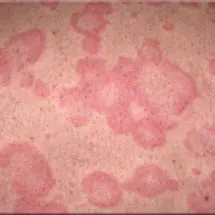
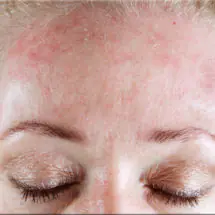
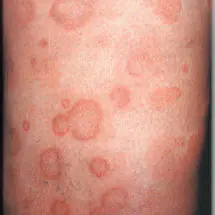

Types of cold allergies
There are several types of cold allergies. Each of them has its own characteristics:
Acute and chronic cold urticaria – this form of the disease is characterized by an acute onset, intense itching of exposed skin areas – the face, hands, and sometimes the entire surface of the body. Soon, swelling of the skin occurs at the itching sites, which manifests itself as a blister. Then rashes appear in the form of intense redness of individual areas of the skin, like a mosquito bite or a nettle sting. In severe forms of the disease, chills, general malaise, joint and muscle pain, palpitations, and severe weakness occur. An exacerbation of the disease can continue for several weeks and even months - the entire cold period of the year;
Recurrent form of urticaria - it is characterized by seasonality: autumn, winter, early spring. Year-round exacerbations occur when the skin is exposed to cold water;
Reflex cold urticaria – a general or local reaction to cold, similar to cholinergic urticaria. Sometimes it occurs only when the whole body cools down. A local reaction to cold is manifested by a rash that appears around the chilled area of the skin, while the skin directly in contact with the cold is not affected;
Familial cold urticaria – a rare form of urticaria, inherited in an autosomal dominant manner. Characterized by a maculopapular rash and burning sensation that occurs 0.5 to 3 hours after exposure to cold. Systemic manifestations of fever, chills, joint pain, and leukocytosis are possible. A rare form of the disease has been described in which urticaria occurs 20 to 30 hours after exposure to cold. Since the rash is accompanied by itching and burning, chronic idiopathic urticaria is often mistakenly diagnosed;
Cold erythema – manifested by redness of the skin (erythema). This form of the disease is characterized by severe pain in the affected areas of the skin;
Cold dermatitis - The skin is very itchy and flaky. If the disease has become quite severe, swelling of the entire body can be observed;
Cold rhinitis - differs from a regular runny nose in that the feeling of nasal congestion occurs exclusively in the cold. As soon as a person suffering from a similar form of cold allergy enters a warm room, all symptoms immediately disappear;
Cold conjunctivitis - in the cold there is strong lacrimation, as well as pain in the eyes.
The described symptoms should not be confused with the body’s natural defense against cold and windy weather, which do not cause significant discomfort and quickly disappear in a warm environment.
Causes of cold allergies

Experts are sure: cold allergy is not an independent disease, but only a symptom that accompanies some kind of physical disease. The body, weakened by a long and latent course of the disease, gives such a response to cold, so the true reasons for the body’s non-standard reaction to cold have not yet been established. There are suggestions that the development of allergies to cold is associated with the production of special cryoglobulin proteins in the body, which are actually the “culprits” for the activation of histamine, which causes allergic reactions. And the main trigger for this is cold. Various predisposing factors help this trigger mechanism work: decreased immunity, infectious, colds and parasitic diseases, for example, chronic throat disease, untreated teeth, inflammatory processes in the gynecological area in women.
A separate point is problems with the gastrointestinal tract: upon examination, it turns out that the person has chronic gastritis or cholecystitis, or an ulcer. In principle, quite a few chronic illnesses can provoke cold urticaria.
Cold allergies in children can also be a continuation of food allergies.
Therefore, all the attention is not on getting rid of symptoms, but on treating the underlying disease. The remaining measures can be considered temporary; they do not solve the problem, they only slightly alleviate the condition.
Treatment of cold allergies

The treatment method for cold allergies is similar to the treatment for true allergies. First of all, it is necessary to avoid contact with the provoking factor, in this case - cold. Winter allergy sufferers need to dress in clothes made from natural fabrics and not be exposed to cold. The degree of sensitivity is individual. For some, allergic reactions occur at an air temperature of minus 24-28°C, for others - minus 8-10°C, for some - after washing with cold water. If hypothermia cannot be avoided, take a warm shower or bath.
Medicines - antihistamines “Suprastin”, “Tavegil”, “Claritin”.
It must be borne in mind that some of them have a hypnotic effect and should not be used while performing work that requires concentration and reaction time, for example, driving a car. For bronchospasms, bronchodilators are used. In severe cases, doctors prescribe plasmapheresis, which clears the blood of cryoglobulins, glucocorticosteroids, and some immunosuppressants.
Most often, cold allergies appear in people who are not hardened and have foci of chronic infection (sore teeth, sinusitis, tonsillitis, bronchitis, cholecystitis, pyelonephritis, etc.). Therefore, it is necessary to pay special attention to their treatment. Liver and intestinal dysfunctions and dysbacteriosis predispose to allergies, including cold allergies.

Treatment of cold allergies with folk remedies
Cold allergies can also be treated with folk remedies.
Raspberries. Pour 0.5 liters of water into 50 g of dry crushed raspberry roots. Simmer over low heat for 30-40 minutes. Then strain and cool. Drink 2 tbsp of the decoction before going out in the morning, after lunch and before bed. spoons. Treatment period is 2 months. If you do not skip taking folk remedies, medications will not be needed. Also drink the decoction for preventative purposes, starting 2 months before the winter cold. Then in winter, you will not feel any symptoms of the disease.
Sunflower seeds and regular red beets. Just eat more unsalted seeds and beets in all types in winter, and also drink half a glass three times a day of freshly squeezed beet juice.
Celery. For cold allergies, drink freshly squeezed celery root juice. It should be taken 0.5 teaspoon before meals, three times a day.
Mumiyo. For a medicinal solution, take 1 g of mummy per 1 liter of boiling water. High-quality raw materials dissolve without sediment. Take once a day in the morning, adults 100 ml. It is possible to treat cold allergies in children in this way, but a single dose for a child 1-3 years old is 50 ml, and for a primary school child - 70 ml.
For cold allergies on the hands and face, you can lubricate the skin with a solution of a higher concentration of 1 g per 100 ml of water.
Blueberries. Grind fresh blueberries and apply them as compresses to the affected areas of the skin.
Emulsion based on celandine, burdock, mint and calendula. If a cold allergy appears on the face, there is no better remedy. Grind and mix 10 g of celandine herb, mint leaves, burdock root and calendula flowers. 5 tbsp. Pour a tablespoon of the herbal mixture with sunflower oil, so that the oil level is 1 cm above the level of the raw material, leave for 24 hours. Sterilize in a water bath, stirring gently. Strain, cool and lubricate the skin. The emulsion perfectly relieves itching and dry skin.
Pine shoots in vegetable oil. In cases where a child’s allergy to cold is manifested by dryness, peeling and redness of the skin, the formation of small cracks and itching, an infusion of pine buds in vegetable oil is prepared. Young pine shoots are infused with vegetable oil in a 1:1 ratio in a dark place for about 5 months. The infusion is gently rubbed into the baby's skin.
Birch sap to reduce allergic swelling. Birch sap is an excellent restorative and regulating salt metabolism with a mild diuretic effect. Its consumption helps to quickly eliminate allergic swelling of the hands and face. You can consume it in unlimited quantities, but for an adult the daily dose should be at least 1 liter. For cold allergies in children, this dose, depending on age, is from 200 to 500 ml. To improve the taste, you can add a little raisins, honey, dried fruits or lemon to the juice, leave for about an hour, and then drink. Not only healthy, but also very tasty.
Walnut tincture. Walnut tincture, which has anti-inflammatory, bactericidal and anti-allergic effects, is prepared from fresh leaves and green pericarp of the walnut, at the rate of 50 g of crushed raw materials per 100 g of vodka or ethyl alcohol diluted to 40°C. Infuse in a tightly closed glass container for a week, shaking daily. The strained tincture is taken 25 drops 3 times a day 20 minutes before meals, diluted in a quarter glass of water. If a child is allergic to cold and has a cough and shortness of breath, it is recommended to give as many drops of tincture as the child is old.
Schisandra juice. If you are bothered by severe itching caused by cold allergies on the face, hands or other parts of the body, you can carefully wipe the skin with lemongrass juice when returning to a warm room, trying not to injure it.
Blue cornflower for the treatment of allergic conjunctivitis. In case of conjunctivitis, as a symptom of cold allergy, treatment is also possible with the help of rinses and lotions from decoctions of medicinal herbs. Most often, a decoction of blue cornflower flowers is used. 1 tbsp. a spoonful of raw materials and 200 ml of boiling water, leave for about 30 minutes and then filter. The resulting decoction is used to wash the eyes or make a lotion from it, soaking gauze pads in it and placing them on the eyes for 15 minutes.
Pine needle baths. Collect twigs along with needles, boil and take baths with this decoction. It is also necessary to wash your face with it in the morning and evening. Take water and needles “by eye”; there are no strict restrictions here.
Prevention of cold allergies

If, fortunately, you are not yet familiar with cold allergies, make a little effort to prevent it, which is very similar to methods for preventing frostbite in the body:
Before going outside during the cold season, lubricate exposed areas of the body with special protective creams against cold and wind. A high-quality nourishing cream is applied to the face half an hour before going outside.
Don't neglect gloves, seasonal hats, warm underwear and tights. Underwear must be made of cotton, because... Synthetics and wool increase the manifestations of cold urticaria. If possible, wear a hood, and the deeper it is, the better. Don't forget about a warm scarf.
At the first signs of a cold allergy, reduce your time outside and do not get too cold.
Hardening by dousing is also a good preventive measure, but you need to start it in the summer and gradually reduce the water temperature.
Before going outside, try not to wash your face and other areas of the body bordering the street with soap, because... it dries out the skin, removing its natural protective film, thereby exposing the skin to the harmful effects of cold on the body.
To avoid cold allergies, as a comprehensive measure, you need to monitor your diet. Meals must be regular. It is worth excluding everything that irritates the mucous membrane of the gastrointestinal tract (GIT), smoked and deep-fried meat - first of all. It is necessary to introduce foods rich in vitamin F (omega-3 fatty acids) into the diet - sea fish and high-quality vegetable oils.
Video about cold allergies
I hope that the information contained in this article will help you and that cold allergies will stop bothering you, and if you have your own methods of dealing with cold allergies, please share, and maybe your advice will be suitable for someone!
Allergic processes that manifest themselves on the body and inside the body often strike – both in summer and winter. Therefore, it is necessary to find means to help eliminate this situation. One of these phenomena is allergy to cold. Symptoms, treatment This factor will be discussed in the article. After all, timely measures taken guarantee an excellent outcome of events. The question also arises - Is it itchy allergy to cold or not?? The answer is clear - Yes! In addition, this phenomenon is accompanied by numerous indicators of symptoms, which will be discussed within this material.
Allergy to cold - what is it?
Cold is a debilitating external irritant that causes an allergic process in a person. Until recently, this factor was questioned by doctors in terms of one or another effect on the body. After all, by nature the phenomenon is not allergic, therefore, if there is no substance, then there cannot be an allergy. However, later it was noticed that under the influence of low temperatures, a significant amount of histamine, during which a state of redness, swelling, burning, itching and pain is observed. This reaction is a consequence of the fact that nerve impulses with skin receptors are transmitted to the human brain. So, does this phenomenon happen in life, what reasons give rise to it?
Causal factors of the phenomenon
Allergy to cold is a possible phenomenon. In modern medicine, there is currently no way to provide complete answers to these questions. In addition, there is a possibility of a possible manifestation of the reaction mechanism, but why exactly the human body reacts to a change in temperature remains unknown. Of course, this type of phenomenon can be observed due to a sharp drop in temperature, as well as when taking a large amount of cold drinks. There is another set of factors that provoke such an interesting phenomenon as frost allergy.
- The presence of other types of allergic processes and phenomena in the body. For example, allergies to pollen, dust or animal dander.
- Various types of infectious processes that are transmitted by humans.
- Oncological formations, hormonal and autoimmune factors.
- The skin nature of the rashes is eczema, dermatitis, papules and vesicles.
- Long-term use of antibiotic drugs.
- The presence of chronic ailments in the body - tonsillitis, sinusitis, caries.
- Helminths that weaken the functions of the immune system of the body and organism.
- Problems related to the functioning of the gastrointestinal tract, liver, kidneys, pancreas.
- Problems with endocrine function.
- Colds, stressful and mentally unstable situations.
Any allergy (including cold allergy) is nothing more than the body’s reaction to a certain type of irritant. The last element is cold, as already noted. Under its influence, a release of histamine occurs, causing skin changes and chills.
The occurrence of this process is based on mast cells in which the reaction appears. They emit the previously mentioned substance and lead to just such a state. This faulty process is rooted in a depleted immune system. Therefore, often an allergic reaction can become a path to another, more serious illness.
Allergy to cold symptoms
In the normal course, people pay attention to the uncomfortable reaction. It doesn't really appear rash on face, but there is redness. A particularly clear manifestation is observed when entering a warm room from the street, where frosty weather reigns. Most often, exposed areas that have been in contact with frost turn red. These are hands and face.
Logic gives a detailed explanation for this: blood rushed to the elements that contracted in the cold, and then to the vessels that managed to expand in warm conditions. But these consequences, including rash on hands, or rather, slight redness, disappears after a few hours.
Subtleties of manifestation of an allergic reaction
These areas can be numerous, but there is a set of basic symptoms that suggest several phenomena.
- Rash on the body, formed within open skin areas. Certainly, rash on legs rarely localized, as well as on the back, thighs, and abdomen. Rather, rashes appear, as already noted, in the area of the face and hands that have been in contact with the cold. The formations can vary in color - from pale pinkish to purple.
- Noticeable blisters and sharp indurations formed within the skin.
- A feeling of severe itching and burning, which can subsequently develop into noticeable peeling.
- The manifestation of noticeable swelling, which is noticeable not only in the area of the skin itself, but also on the mucous membranes - on the larynx, lips, tongue, sinuses.
- Producing noticeable coughing and sneezing.
- The condition is accompanied by severe pain in the head area, as well as chills.
So, we looked at how allergies to cold manifest themselves. We will consider what to do in this situation further.
Alternative names for the phenomenon
- Cold type urticaria. Accompanied by rashes that are similar to nettle burns, accompanied by the formation of swelling and blisters.
- Cold dermatitis - manifests itself not only as a previous phenomenon, blisters and redness, peeling and itching also occur.
- Conjunctivitis is of the same nature - here the number of tears increases. Unpleasant pain and swelling also occur.
- Cold rhinitis - the similarity of symptoms with the usual phenomenon is obvious, however, when the sick person is in a warmer room, the symptoms “disappear”.
- Asthma of the same nature is accompanied by the formation of edema in the larynx, shortness of breath and other consequences.
So, rash, photo which can be seen in the article, is localized in several favorite areas and poses a danger to the skin and the condition of the mucous membranes. Therefore, it is necessary to find measures to treat these conditions so that the patient can feel great.
Allergy to cold sneezing and runny nose
Two more important symptoms that an allergy to cold has are a runny nose and sneezing. This indicates a weak immune system. Perhaps the reason for this is the presence of cold pathogens in the body. A runny nose when entering a warm room may initially get worse, but then disappear. When going outside, a person may suffer from severe sneezing, which continues when he gets home. An important factor that causes an allergy to cold is the whole body itching. In this case, the phenomenon may indicate other diseases.
Allergy to cold on hands
The definition of disease comes down to to take a home test by applying a small piece of ice to the forearm area. If after 10 minutes this area turns white, then your concerns are unfounded. If a blister or severe swelling appears - reason to sound the alarm present.
If an allergic reaction occurs in the area of the hands, which is shown in the photo, a number of measures must be taken. These formations itch, itch and hurt, adding a lot of aesthetic inconvenience to the overall picture.
What to do
If a cold allergy appears on your hands, you need to accustom your body to the correct response to external influences of the cold type. To do this, you need to dress as warmly as possible and, if necessary, use two pairs of ropes and gloves. Prevention measures include preventing the phenomenon during remission, but what to do if the rash makes itself felt and you need an urgent solution to the problem.
You need to see a doctor who will prescribe a set of medications. The most effective therapeutic measures will be discussed in the article, but for now, look at what an allergy to cold looks like (photo).
Preventive complex
- Lubricating your hands with high-fat cream before going outside.
- Choosing clothes made from natural materials.
- Avoid noticeable temperature changes and dress appropriately for the weather.
- Covering your hands with gloves in severe frost and cold conditions.
- Reviewing your own diet and adding dishes.
Photos of your hands will be more attractive if you learn to follow these safety measures.
Allergy to cold on the face
The face is a skin area that always remains open. Therefore, with the disease there is a noticeable rash in adults, which is accompanied by the formation of a large number of pustules, papules, peeling and, of course, the most unpleasant symptom - itching. It is important to use all the preventive measures given in the previous paragraph, as well as smear your face with a rich cream before going out into the cold and wind. If you wear heavy makeup, the product that acts as a base should be targeted and of high quality.
It is also necessary to smear your lips with oily lipstick, this will prevent chapping. So, we looked at how an allergy to cold manifests itself on the face. Photos of adults are presented within this material. Small children are similarly susceptible to the allergic process.
therefore it may also occur baby rashwhich needs urgent elimination. To do this, you need to take certain medications, the complex of which will be discussed below.
Allergy to cold treatment ointment
If you have already interacted with the cold and have just entered a warm room, you need to take a number of actions to avoid a negative reaction.
- Warm up by drinking warm tea, crawl under a warm blanket.
- If you are concerned about rashes, you should use antihistamines.
- If the mucous membrane reacts poorly to cold, it is necessary to drip drops before going outside.
- If this phenomenon is chronic, take the medication orally.
So, we looked at how to behave if you are allergic to cold.
How to treat this phenomenon?
There is a set of ointments that will help alleviate your general condition and create conditions for quickly eliminating the rash.
- GISTAN N - an antihistamine composition that can be purchased at any pharmacy. It contains a hormonal substance, and this factor is important to take into account.
- SKIN AP will help ensure quality treatment. The ointment is also hormonal, but it has an amazing effect and gives immediate results.
- If you are a supporter of medicinal plants, doctors recommend using LA CREE. But the composition can be used only in the absence of allergies.
- PANTHENOL helps protect against allergies and helps answer the question of what to smear your hands with when in contact with frost.
It is important to know what to apply on your face in order to prevent the phenomenon. These can be high-quality cosmetics and pharmaceutical preparations that provide high-quality treatment on the face. In general, it is best to consult a specialist who will give practical advice and conduct a full examination.
Cold allergy treatment with folk remedies
Traditional medicine, contrary to the conflicting opinions of doctors, is strong and merciless in relation to many diseases. The tactics of the treatment process are chosen according to the difficulties that this entire period brings. Traditional medicines can provide real benefits together with medications if the schedule of use is agreed upon with the doctor. The main thing is to prepare the composition correctly, this will create good health for you and your family.
- Blueberry compresses, which are ground into a pulp state in advance. These compositions help relieve swelling and are also used for a number of other skin diseases. The only disadvantage of this technique is the dark color of the berries, which quickly stains the skin. But for the sake of an attractive appearance, you can be patient.
- Oil emulsion, made on the basis of medicinal herbs - calendula, celandine, burdock, mint. This remedy is effective in cases of dry skin and cracking. The composition helps to effectively eliminate the sensation of itching and pain.
- Tincture, made through shoots and buds in vegetable oil. The advantage of the technique is that it can be used for children. This product copes well with the feeling of itching and redness on the skin. Thanks to it, you can remove all dryness and flaking of the epithelium.
- Birch sap has long been famous for its excellent properties. It was often used internally for children. It is believed that the smallest inhabitants of the planet need to drink up to 500 ml per day, and adults – up to 1,000 ml.
- Schisandra juice, by means of which areas of the skin with an increased sensation of itching are wiped, helps to improve the general condition.
We looked at cold allergy symptoms and treatment. Have you observed this? Leave your opinion or review for everyone by visiting our allergy forum



